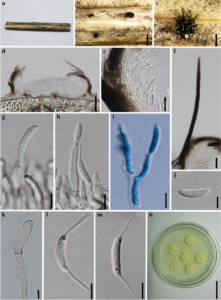Dinemasporium nelloi W.J. Li, Camporesi & K.D.Hyde, in Liu et al., Fungal Diversity: 10.1007/s13225-015-0324-y, [18] (2015)
Index Fungorum number: IF550919, Facesoffungi number: FoF00424
Etymology – Named after Nello Camporesi, who collected the sample from which the species was isolated.
Holotypus – MFLU 14–0811
Saprobic on the dead stem of Dactylis glomerata L., forming conspicuous, rounded to irregular, black, conidiomata. Sexual morph Undetermined. Asexual morph coelomycetous. Conidiomata 100–200μm high, 250–350μm diam., pycnidial, superficial, erumpent, cupulate when dry, solitary, scattered or gregarious, black, with stroma cells of textura angularis at the base and a lateral excipulum of textura porrecta or textura intricata of pale to dark brown cells. Setae divergent, stiff, brown, smooth-walled, septate, tapering towards an acute apex. Conidiophores cylindrical, septate, smooth, thick-walled, hyaline, arising from basal and periclinal wall cells. Conidiogenous cells 10–15 μm long×1.5–3.5 μm wide, phialidic, cylindrical, hyaline, smooth-walled, tapering toward the apex. Conidia 10–20×2.5–3.5 μm (x=15×3; n=20), blastic-phialidic, amerosporous, allantoid or lenticular, guttulate, hyaline, smooth-walled, with a single unbranched setula at each end; setula 5–15 μm long×0.5–1.5 μm wide.
Culture characters – Colonies on PDA slow growing, white in the first few days, becoming yellowish, and reaching 20– 25 mm diam. after one week, with the middle area becoming pink, whitened at the edge, becoming felt-like after two weeks, dense, aerial, filamentous; reverse brown, pigments produced.
Material examined – ITALY, Province of Forlì-Cesena [FC], Castrocaro Terme, Converselle, on dead stem of Dactylis glomerata L. (Poaceae), 1 December 2012, E. Camporesi IT-934 (MFLU 14–0811, holotype), ex-type living culture, MFLUCC 13–0482. ibid., HKAS 83970, isotype.
GenBank accession numbers – ITS: KP711358; LSU: KP711363; SSU: KP711368.
Notes – Dinemasporium was introduced by Léveillé (1846)with D. graminum (Lib.) Lév. as the type species. This is a comparatively large heterogeneous genus in which 85 taxa have been recorded, according to the Index Fungorum (2015). The species of Dinemasporium are characterized by superficial, cupulate conidiomata with setae; “phialidic” conidiogenous cells; and hyaline, oblong to allantoid conidia with a single appendage at each end (Sutton 1980; Nag Raj 1993). Dinemasporium nelloi is morphologically similar to D. americana, D. morbidum and D. polygonum. However, D. nelloi produces conidia that are much longer than in these species (i.e. (9–)12–13(–16) μm long in D. americana, 8– 13μm long in D. morbidum and (9–)10–12(–13) μm long in D. polygonum), although shorter than D. lanatum (13–27μm long) (Nag Raj 1993; Crous et al. 2012). According to the LSU sequence data, D. nelloi is distinct from any other species within Dinemasporium. Combined with morphological data and molecular data, we introduce the new species, Dinemasporium nelloi.

Fig. 1 Dinemasporium nelloi (holotype) a Specimen b, c Black conidiomata on the host surface d Vertical section of conidioma e Section of peridium f Seta g–i Conidiogenous cells and developing conidia j, l–m Conidia k Germinated conidia n Culture on PDA. Scale bars: b=500μm, c=100μm, d=50μm, e=10μm, f=20μm, g–m=5μm, n=25 mm.
